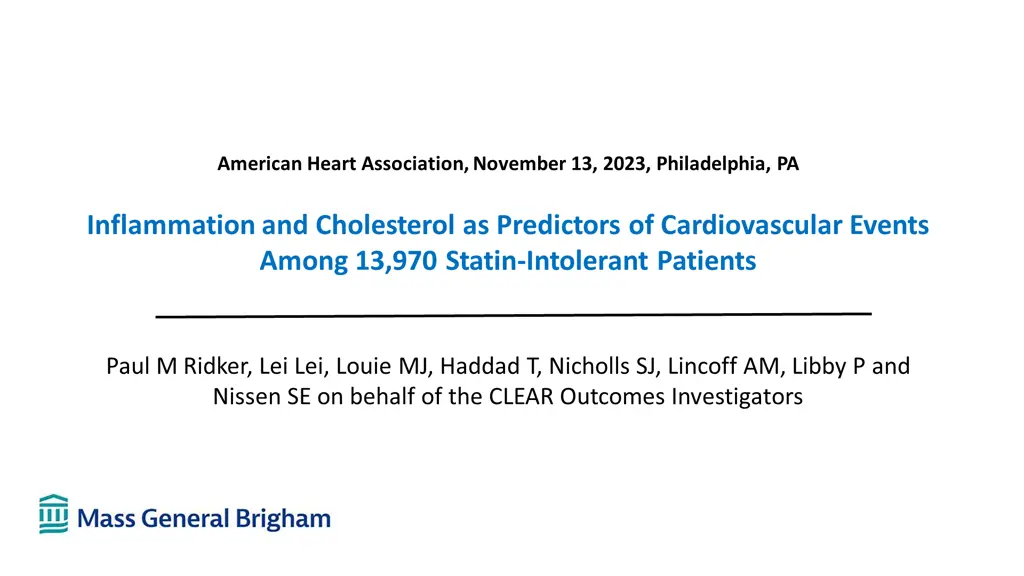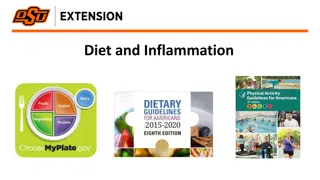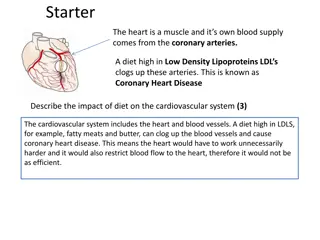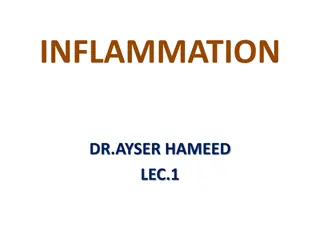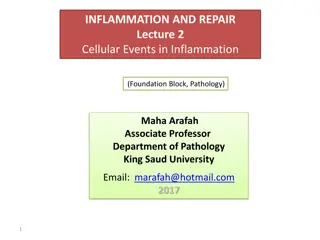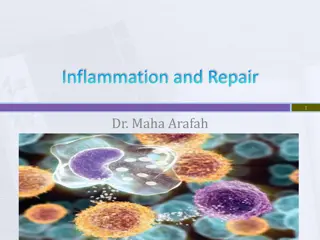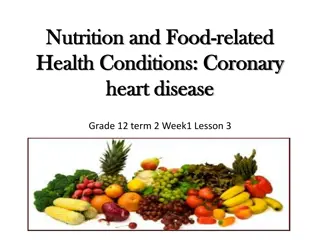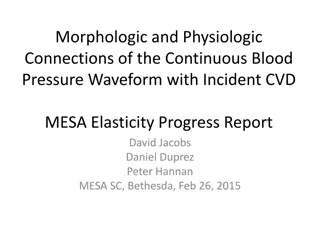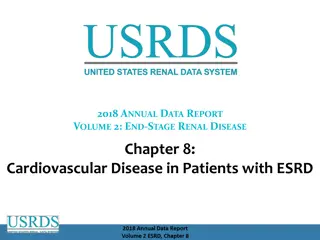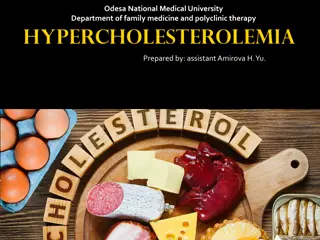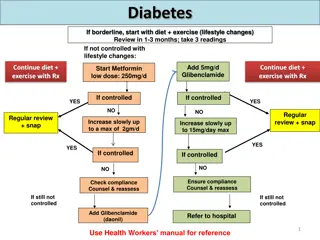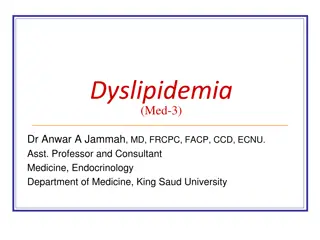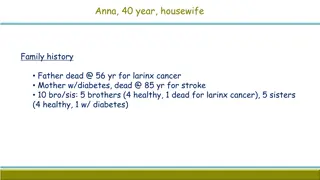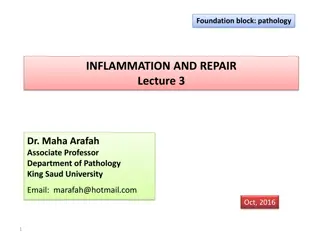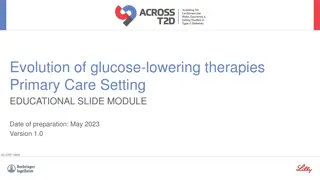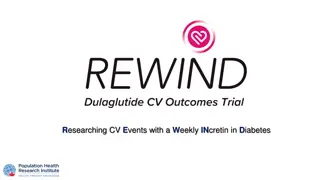Inflammation and Cholesterol Predicting Cardiovascular Events
This study explores how inflammation and cholesterol levels predict cardiovascular events among 13,970 statin-intolerant patients in the CLEAR Outcomes trial. Findings suggest residual inflammatory risk may be a stronger predictor than residual cholesterol risk for future events. The research analyzes the contemporary relationship between hsCRP and LDL-C and their impact on cardiovascular outcomes in patients unable to tolerate statins. This examination may have significant implications for patient care and cardiovascular event prevention strategies.
Download Presentation

Please find below an Image/Link to download the presentation.
The content on the website is provided AS IS for your information and personal use only. It may not be sold, licensed, or shared on other websites without obtaining consent from the author.If you encounter any issues during the download, it is possible that the publisher has removed the file from their server.
You are allowed to download the files provided on this website for personal or commercial use, subject to the condition that they are used lawfully. All files are the property of their respective owners.
The content on the website is provided AS IS for your information and personal use only. It may not be sold, licensed, or shared on other websites without obtaining consent from the author.
E N D
Presentation Transcript
American Heart Association, November 13, 2023, Philadelphia, PA Inflammation and Cholesterol as Predictors of Cardiovascular Events Among 13,970 Statin-Intolerant Patients Paul M Ridker, Lei Lei, Louie MJ, Haddad T, Nicholls SJ, Lincoff AM, Libby P and Nissen SE on behalf of the CLEAR Outcomes Investigators
Background and Rationale - I Inflammation and hyperlipidemia jointly contribute to initiation, progression, and eventual plaque rupture leading to myocardial infarction, stroke, and cardiovascular death. A recent analysis1 of 31,245 contemporary statin-treated patients in the PROMINENT, REDUCE-IT, and STRENGTH trials demonstrated that residual inflammatory risk (assessed by hsCRP) was a more powerful predictor of future cardiovascular events than was residual cholesterol risk (assessed by LDLC). This issue has substantial implications for care as low-dose colchicine, bempedoic acid, GLP-1r agonists, and SGLT2 inhibitors all lower hsCRP and all are associated with lower risks of future cardiovascular events. 1Lancet 2023;401:1293-1301
hsCRP is a More Powerful Determinant of Cardiovascular Death than LDLC Among 31,245 Contemporary Statin Treated Patients Pooled Data (N = 31,245) Cardiovascular Death PROMINENT (N = 9,988) HR 2.68 * P < 0.0001 + P < 0.05 HR 1.27 REDUCE-IT (N = 8,179) STRENGTH (N = 13,078) LDLC hsCRP Lancet 2023;401:1293-1301
Background and Rationale - II Not all patients can tolerate statin therapy. The contemporary relationships of hsCRP and LDLC to cardiovascular risk are uncertain for those not taking statins. Completion of the CLEAR Outcomes trial (N = 13,970) comparing bempedoic acid to placebo among statin-intolerant patents with, or at high risk, for ASCVD afforded us the opportunity to evaluate the contemporary relationships of hsCRP (a clinical biomarker for residual inflammatory risk) and LDL-C (a clinical biomarker for residual cholesterol risk) with the incidence of future major adverse cardiovascular events (MACE), cardiovascular mortality, and all-cause mortality.
Methods 13,970 statin-intolerant participants in the contemporary CLEAR Outcomes trial in which individuals with LDLC > 100 mg/dL were randomly allocated to 180 mg bempedoic acid QD or to placebo at 1250 sites in 32 countries and followed for a median period of 40.6 months (maximum 5 years). Population: As reported elsewhere (Nissen et al, NEJM 2023), the trial included a secondary prevention cohort (N = 9764) and a high-risk primary prevention cohort (N = 4206), both inclusive of patients unable or unwilling to take statin therapy owing to an adverse effect that started or increased during statin therapy and/or resolved or improved after statin discontinuation. Incident 4-PointMACE, CV mortality, and all-cause mortality during trial follow-up Endpoints: For our primary analysis, we computed adjusted HRs (95%CIs) in proportional hazard models addressing risks for each endpoint across increasing quartiles of hsCRP and LDL-C. All analyses adjusted on an a priori basis for age, gender, BMI, smoking, alcohol, blood pressure, diabetes, eGFR, history of atherosclerotic disease, and randomized treatment assignment. The relative benefits of bempedoic acid as compared to placebo were also assessed across hsCRP and LDLC strata. Statistical Analysis:
Results I Clinical characteristics of statin-intolerant participants in the CLEAR Outcomes trial Characteristic Bempedoic Acid (N = 6992) Placebo (N = 6978) Age, years 65.5 65.5 Female, % 48.1 48.4 Diabetes, % Body Mass Index, kg/m2 45.0 46.3 29.9 30.0 Secondary Prevention, % 70.0 69.8 Triglycerides, mg/dL 159.5 158.5 LDL-C, mg/dL 139.0 139.0 HDL-C, mg/dL 49.6 49.4 hsCRP, mg/L 2.3 2.3
Results II Comparison of cut-points for baseline hsCRP and LDL-C among 31,245 statin-treated participants in the PROMINENT, REDUCE-IT, and STRENGTH trials and among 13,970 statin-intolerant participants in the CLEAR Outcomes trial Quartile Cut-points for hsCRP (mg/L) Quartile 1 Quartile 2 Quartile 3 Quartile 4 <1.1 1.2-2.2 2.3-4.5 > 4.5 Statin-Treated < 1.2 1.2-2.3 2.3-4.5 > 4.5 Statin-Intolerant Quartile Cut-points for LDL-C (mg/dL) Quartile 1 Quartile 2 Quartile 3 Quartile 4 <60 60-76 76-96 > 96 Statin-Treated < 115 115-135 135-159 > 159 Statin-Intolerant
Results III Hazard Ratios for Incident MACE Among 13,970 Statin-Intolerant Patients Residual Inflammatory Risk (Quartiles of hsCRP) Quartile 1 <1.2 mg/L 1.0 Quartile 2 1.2-2.3 mg/L 1.19 Quartile 3 2.3-4.5 mg/L 1.24 Quartile 4 > 4.5 mg/L 1.43 HR, adjusted* 95% CI Referent 1.03 1.37 1.07 1.43 1.24 1.65 P-value Referent 0.02 0.004 < 0.0001 Residual Cholesterol Risk (Quartiles of LDL-C) Quartile 1 < 115 mg/dL 1.0 Quartile 2 115-135 mg/dL 1.01 Quartile 3 135-159 mg/dL 1.18 Quartile 4 > 159 mg/dL 1.19 HR, adjusted* 95% CI referent 0.88 1.15 1.03 1.35 1.04 1.37 P-value referent 0.93 0.02 0.01 * adjusted for age, gender, body mass index, smoking, blood pressure, prior history of CVD, and randomized treatment assignment
Results III Hazard Ratios for CV Death Among 13,970 Statin-Intolerant Patients Residual Inflammatory Risk (Quartiles of hsCRP) Quartile 1 <1.2 mg/L 1.0 Quartile 2 1.2-2.3 mg/L 1.31 Quartile 3 2.3-4.5 mg/L 1.58 Quartile 4 > 4.5 mg/L 2.00 HR, adjusted* 95% CI Referent 0.99 - 1.73 1.20 2.07 1.53 2.61 P-value Referent 0.06 0.001 < 0.0001 Residual Cholesterol Risk (Quartiles of LDL-C) Quartile 1 < 115 mg/dL 1.0 Quartile 2 115-135 mg/dL 0.93 Quartile 3 135-159 mg/dL 1.02 Quartile 4 > 159 mg/dL 0.90 HR, adjusted* 95% CI referent 0.74 1.18 0.80 1.29 0.70 1.17 P-value referent 0.57 0.89 0.44 * adjusted for age, gender, body mass index, smoking, blood pressure, prior history of CVD, and randomized treatment assignment
Results III Hazard Ratios for Total Mortality Among 13,970 Statin-Intolerant Patients Residual Inflammatory Risk (Quartiles of hsCRP) Quartile 1 <1.2 mg/L 1.0 Quartile 2 1.2-2.3 mg/L 1.33 Quartile 3 2.3-4.5 mg/L 1.70 Quartile 4 > 4.5 mg/L 2.21 HR, adjusted* 95% CI Referent 1.06 1.66 1.37 2.11 1.79 2.73 P-value Referent 0.01 <0.0001 < 0.0001 Residual Cholesterol Risk (Quartiles of LDL-C) Quartile 1 < 115 mg/dL 1.0 Quartile 2 115-135 mg/dL 0.93 Quartile 3 135-159 mg/dL 0.98 Quartile 4 > 159 mg/dL 0.95 HR, adjusted* 95% CI referent 0.77 1.12 0.81 1.18 0.78 1.16 P-value referent 0.42 0.79 0.60 * adjusted for age, gender, body mass index, smoking, blood pressure, prior history of CVD, and randomized treatment assignment
Results VI Similar Efficacy of Bempedoic Acid Across hsCRP and LDLC Subgroups Participant Group Bempedoic Acid n/N (%) Placebo n/N (%) HR 95% CI 4-point MACE* Total Cohort 819/6992 (11.7%) 927/6978 (13.3%) 0.87 0.79-0.96 hsCRP < 2 mg/L 320/3070 (10.4%) 352/3071 (11.5%) 0.89 0.77-1.04 hsCRP > 2 mg/L 493/3847 (12.8%) 567/3840 (14.8%) 0.86 0.76-0.97 LDLC < 130 mg/dL 351/3074 (11.4%) 396/3089 (12.8%) 0.88 0.76-1.02 LDLC > 130 mg/dL 468/3918 (11.9%) 51/3889 (13.7%) 0.86 0.76-0.98 * 4-point MACE: nonfatal myocardial infarction, nonfatal stroke, coronary revascularization, or cardiovascular death
Direct Comparison of hsCRP and LDLC as Predictors of Cardiovascular Death in Contemporary Data - Part I LDLC hsCRP Quartile 1 Quartile 2 Statin-Treated (N = 31,245) 76 mg/dl 2.1 mg/L Quartile 3 Quartile 4 0.5 1.0 2.0 0.5 1.0 2.0 Quartile 1 Statin-Intolerant (N = 13,970) Quartile 2 135 mg/dl 2.3 mg/L Quartile 3 Quartile 4 0.5 1.0 2.0 0.5 1.0 2.0 Hazard Ratio (95% CI)
Direct Comparison of hsCRP and LDLC as Predictors of Cardiovascular Death in Contemporary Data - Part II Highest Risk hsCRP > 2 mg/L LDLC > or < 70 mg/dL Statin-Treated (N = 31,245) Statin-Intolerant (N = 13,970) Highest Risk hsCRP > 2 mg/L LDLC > or < 130 mg/dL
Summary: In a pattern almost identical to prior data among 31,245 contemporary statin-treated patients in the PROMINENT, REDUCE-IT, and STRENGTH trials, residual inflammatory risk as assessed by hsCRP was a stronger determinant of risk for future cardiovascular events and death than residual cholesterol risk as assessed by LDL-C among 13,970 contemporary statin-intolerant patients in the CLEAR Outcomes trial. In both contemporary settings, individuals with elevated hsCRP were at high cardiovascular risk irrespective of LDLC level. Bempedoic acid, an agent that lowers both LDLC and hsCRP, was equally effective across LDLC and hsCRP strata.
Implications for practice While these data must not be construed to diminish the proven and crucial role of lipid- lowering for our patients with hypercholesterolemia, they do suggest that targeting of LDLC alone is unlikely to completely reduce atherosclerotic risk and that inflammatory pathways have yet to be fully exploited to reduce fatal and nonfatal CV events. In contemporary care, moving beyond LDLC alone, should clinicians consider inflammation inhibition for patients with atherosclerotic disease? Consideration of colchicine 0.5 mg po qd for those with stable atherosclerosis and normal eGFR. Consideration of bempedoic acid which, like statin therapy, reduces both LDL-C and hsCRP Consideration of GLP1r agonists and SGLT2 inhibitors, all of which have concomitant anti-inflammatory effects.
Implications for practice It is not an either/or situation: In the future, we believe the combined use of aggressive LDL-lowering and inflammation inhibiting therapies will become standard of care for almost all atherosclerotic patients. Finally, in addition to increasing the use of targeted anti-inflammatory therapies for atherosclerosis, these data strongly support ongoing ACC/AHA prevention efforts directed at diet, weight loss, exercise, and smoking cessation, all of which lower vascular inflammation and lower cardiovascular event rates.
